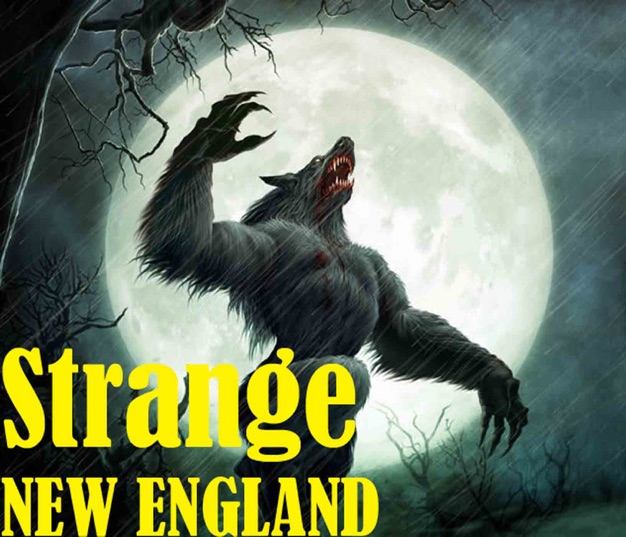
Strange New England
Strange New England
A Field Guide to New England's Legends, Folklore, Curious History & Weird Destinations
- 7 minutes 51 secondsThe Glocester Ghoul
 Some might say that northwestern Rhode Island had been cursed by some dark force in the past. It has been the source of many foul tales of devilish specters and hideous brutes. Its forests appear darker and colder than others. On all sides are ancient trees with branches that writhe like tendrils over its roads. As a fog settles over the evening, you can’t escape the feeling that stygian beast skulks within it. Though you might expect these sensations are borne from the darkest corners of our imagination, there are five men who would strongly disagree. For one late night in Glocester, Rhode Island, they encountered a fiend like no other; the Glocester Ghoul.
Some might say that northwestern Rhode Island had been cursed by some dark force in the past. It has been the source of many foul tales of devilish specters and hideous brutes. Its forests appear darker and colder than others. On all sides are ancient trees with branches that writhe like tendrils over its roads. As a fog settles over the evening, you can’t escape the feeling that stygian beast skulks within it. Though you might expect these sensations are borne from the darkest corners of our imagination, there are five men who would strongly disagree. For one late night in Glocester, Rhode Island, they encountered a fiend like no other; the Glocester Ghoul.Albert Hicks, the last person to be executed for piracy in America, was born in Foster, Rhode Island in 1820. He had one ambition in life: to become rich by some bold stroke. He said that the only value his wealth would have was to gratify his passions with no restraint.
His career as a pirate and criminal involved many monstrous deeds. In his confession, Hicks said, that the devil,
 whose work he was doing so industriously, seemed to protect him while he pursued a career of blood and crime with impunity. “He has stood by me all my life, on ship and on shore; amid the howling storms of the ocean,” Hicks said, “where every moment the waves threatened to ingulf (sic) me, he has snatched me from their deadly embrace; on the battle-field, in many a hand-to-hand fight he has seemed to stand by my side, protecting me from danger; and when I have been in the hands of my enemies, and escape has appeared impossible, he has, until now, invariably opened the way for my release.”
whose work he was doing so industriously, seemed to protect him while he pursued a career of blood and crime with impunity. “He has stood by me all my life, on ship and on shore; amid the howling storms of the ocean,” Hicks said, “where every moment the waves threatened to ingulf (sic) me, he has snatched me from their deadly embrace; on the battle-field, in many a hand-to-hand fight he has seemed to stand by my side, protecting me from danger; and when I have been in the hands of my enemies, and escape has appeared impossible, he has, until now, invariably opened the way for my release.”Though the devil may have been by his side while he was involved in a nefarious life, his first encounter with him or one of his hellhounds may have been back home in Foster, Rhode Island.
While living in Foster, he was fascinated by stories of pirates, robbers and highwaymen. He was often riveted by tales his friends shared with him. One claimed that pots of silver and gold had been buried in their neighborhood by Captain Kidd. Hicks often found himself dreaming of finding the stash that was secreted somewhere nearby. He could feel the gold calling to him.
 In the summer of 1839, Hicks had grown confident that Kidd’s treasure was lying somewhere on Paige Farm. He had heard that some Spanish doubloons had been previously found on the farm. Hicks and three fellow Glocesterites decided they would claim this hoard under the cloak of night.
In the summer of 1839, Hicks had grown confident that Kidd’s treasure was lying somewhere on Paige Farm. He had heard that some Spanish doubloons had been previously found on the farm. Hicks and three fellow Glocesterites decided they would claim this hoard under the cloak of night.Manned with shovels and picks, Hicks and his hooligans set out to claim the treasure. Once on the farm they began to dig feverously for Kidd’s supposed buried gold. It wasn’t long before their effort was interrupted by a strange sound. They stopped their work and listened with caution. Had their venture been discovered? As they looked up, emerging from the dark forest in front of them was an edldritch horror. Quickly, they dropped their tools and ran for their lives.
Hicks described the beast as “… a large animal, with staring eyes as big as pewter bowls. The eyes looked like balls of fire. When it breathed as it went by, flames came out of its mouth and nostrils, scorching the brush in its path. It was
 as a big as a cow with dark wings on each side like a bat’s. It had spiral horns like a ram’s, as big around as a stovepipe. Its feet were formed like a duck’s and measured a foot and a half across. The body was covered with scales as big as clamshells, which made a rattling noise as the beast moved along. The scales flopped up and down. The thing had lights on its sides like those shining through a tin lantern. Before I saw it I felt its presence and I smelled something that was like burnt wool as it went by. I had a feeling of suffocation when it came near me. The monster seemed to come from nowhere and to go away in the same manner.”
as a big as a cow with dark wings on each side like a bat’s. It had spiral horns like a ram’s, as big around as a stovepipe. Its feet were formed like a duck’s and measured a foot and a half across. The body was covered with scales as big as clamshells, which made a rattling noise as the beast moved along. The scales flopped up and down. The thing had lights on its sides like those shining through a tin lantern. Before I saw it I felt its presence and I smelled something that was like burnt wool as it went by. I had a feeling of suffocation when it came near me. The monster seemed to come from nowhere and to go away in the same manner.”After having seen that frightening beast, neither Hicks nor any of his fellow treasure hunters would ever return to Paige farm to claim the treasure. They were never sure exactly what it was they saw. It may have been some sort of hellhound guarding Kidd’s ill-gotten goods, or one of the several creatures described in local lore that lived in the nearby swamps and deep forest.
The beast wasn’t seen again until 1896 by Glocester resident Neil Hopkins. The story of his encounter was reported in January 15th, 1896 edition of The Evening Hour. On the cold winter evening of January 13, Neil was on his way home from work in Putnam, Connecticut. Though he had traveled this path alone many times before, this evening he
 had a troubled feeling. When Neil reached the darkest point on his route, he heard a sound from deep in the forest quickly moving toward him. Suddenly, as if from out of some gateway from hell, a supernatural creature came charging from the darkness and began to pursue him. “It seemed to be all a-fire; it had a hot breath,” Neil explained. “There was a metallic sound, like the clanking of steel against steel. The beast didn’t seem to be strong in the wind, for it chased me only a short distance, and then plunged off into the woods. I could hear the dead branches and twigs crackling under the heavy tramp.”
had a troubled feeling. When Neil reached the darkest point on his route, he heard a sound from deep in the forest quickly moving toward him. Suddenly, as if from out of some gateway from hell, a supernatural creature came charging from the darkness and began to pursue him. “It seemed to be all a-fire; it had a hot breath,” Neil explained. “There was a metallic sound, like the clanking of steel against steel. The beast didn’t seem to be strong in the wind, for it chased me only a short distance, and then plunged off into the woods. I could hear the dead branches and twigs crackling under the heavy tramp.”Neil said that whatever it was he saw, it was as large as an elephant, but it had no tail. Those who heard about his horrible encounter were not sure exactly what it could have been. Some believed it was a bear that had been seen recently in Webster, Massachusetts, and as far south as Glocester. Others thought it was the famous Glocester monster, the “burning beast” that Pirate Hicks had seen 57 years ago.
There are those who believe that the beast still haunts the forest not far from the Providence Turnpike. If you happen to find yourself to be this beast’s next unlucky victim, keep in mind that it has never been known to take a life. What we do know though, is that during Pirate Hicks’ confession, he said, “the devil took possession of me.” Maybe what this devilish creature is out to do is to consume your soul!
~Strange New England


Glocester Ghoul

Show embedded map in full-screen modeSources:
The life, trial, confession and execution of Albert W. Hicks, the pirate and murderer
The Evening Hour, January 15th 1896 – Connecticut
History of the State of Rhode Island – Albert J Wright 1878
Share Tweet ShareThe post The Glocester Ghoul appeared first on Strange New England.
22 October 2017, 10:20 pm - 5 minutes 35 secondsThe Glowing Thing of Moore Lake

 The Connecticut River is the largest river in New England. It meanders its way through the hills and forest of Northern New England between Vermont and New Hampshire and discharges itself in Long Island Sound. This leviathan consumes over 11,263 sq miles of the Northeast. Traced by many cities and small towns, it’s an icon of the New England lifestyle. Though seemingly beautiful and peaceful by day, its undulating coils hide many stories and secrets along its path to the Devil’s Belt. One is a mysterious glowing thing that lurks in its waters.
The Connecticut River is the largest river in New England. It meanders its way through the hills and forest of Northern New England between Vermont and New Hampshire and discharges itself in Long Island Sound. This leviathan consumes over 11,263 sq miles of the Northeast. Traced by many cities and small towns, it’s an icon of the New England lifestyle. Though seemingly beautiful and peaceful by day, its undulating coils hide many stories and secrets along its path to the Devil’s Belt. One is a mysterious glowing thing that lurks in its waters.In 1956, a portion of the Connecticut River was dammed up for the purpose of hydroelectric power production. Though formally named the Samuel Moore Reservoir, the residents of Littleton, New Hampshire refer to it as Moore Lake. It became a staple for summer fun for the people of Littleton, but on the evening of May 20th, 1968 a few would find something other than fun at Moore Lake.
Around 3 am Monday morning, what had been a quiet evening for the night officer of the Littleton Police Department came to a sudden end when three seemingly terrified youths
 stormed into the station. They were so delirious officer Miller only heard, “red glow on the water,” and “thing”, in the anxious chatter. The one thing the officer Miller did understand was that whatever it was these three saw, it had terrorized them. Richard, his wife Cindy and Michael were now feeling safe in the company of the officer. Soon they were relaxed enough to begin to clearly tell their story.
stormed into the station. They were so delirious officer Miller only heard, “red glow on the water,” and “thing”, in the anxious chatter. The one thing the officer Miller did understand was that whatever it was these three saw, it had terrorized them. Richard, his wife Cindy and Michael were now feeling safe in the company of the officer. Soon they were relaxed enough to begin to clearly tell their story.That evening the three of them had decided to go fishing for horned pout at Samuel C. Moore Lake. They decided on a remote spot west of Route 135. After negotiating two miles of winding dirt road, they found themselves at a picnic area with a boat launch along the east side of the lake around 1 am. The first hour was uneventful. Though they had not gotten a nibble, they were still enjoying the peaceful night.
Around 2 am Michael suddenly noticed a strange red glow in the water. It was adjacent to a rock ledge about a quarter of a mile from their location. Though odd, they had no reason to be concerned and soon forgot about it. That is, until they noticed how unusually quiet it had become. “No frogs croaking, no animals moving around in the woods,” Richard explained, “No night noises at all.” So quiet that all they could hear was the plop of their lures and the gurgling they made as they reeled them in.
 Suddenly they noticed the red glow had now moved away from the ledge and was now in the lake in front of them. “Look at that,” Richard shouted as he noticed it was only 30 feet from the dock. Richard described it as, “a whitish mound about two feet wide extending a foot above the surface.” Just above the waterline were what appeared to be two red glowing eyes. What was even more frightening was that behind the mound was what appeared to be an even larger shape lurking in the shadows. Michael would later describe it as, “having the head of an alligator submerged up to its eyes.”
Suddenly they noticed the red glow had now moved away from the ledge and was now in the lake in front of them. “Look at that,” Richard shouted as he noticed it was only 30 feet from the dock. Richard described it as, “a whitish mound about two feet wide extending a foot above the surface.” Just above the waterline were what appeared to be two red glowing eyes. What was even more frightening was that behind the mound was what appeared to be an even larger shape lurking in the shadows. Michael would later describe it as, “having the head of an alligator submerged up to its eyes.”Quickly Cindy and Michael scrambled from the dock and onto the shore. Richard, still on the dock, watched as the object lay motionless in the water in front of him. Curious as to what it was, Richard tossed his line out to it. As he began to reel it back in, suddenly the creature began to charge toward the dock. “Dick, it’s coming at you,” Cindy shouted. Cindy and Michael heard what sounded like a bubbling noise as it raced toward them. The three of them darted for the car and drove off. As they looked back, they could see the red glow filling the water around dock.
The next day Littleton Police Chief McIntyre sent officers to the lake to investigate the incident further. What was found was horned pout strewn all along the shore near the dock. All that remained of the fish were the heads, spines and tails. It was as if they were consumed by something with a very large appetite. Though no one was ever quite sure what those three had encountered that evening, the one thing they were sure of was that they saw something that had frightened them.
Locals that live close to the lake reported later sightings of an odd red glowing. Many rumors about other sightings and strange events at Moore Lake continued, though there were no close encounters like that of Richard, Mike and Cindy. To this day what was seen still remains a mystery. Though there have been no sightings of the Glowing Thing in many years, on some occasion an evening angler notices a strange calm fall upon the lake. Some say they get an eerie sensation of being watch by someone, or something.
~ Strange New England
Moore Lake

Show embedded map in full-screen mode
Share Tweet ShareThe post The Glowing Thing of Moore Lake appeared first on Strange New England.
14 October 2017, 8:25 pm - 7 minutes 1 secondThe Connecticut River Serpent

Hidden within the undulating arm of the Connecticut River is a serpent that has frightened those who’ve lived on it banks since colonists first settled there. Often it has been described as an eel or snake-like serpent over one hundred feet long. Though over the past three hundred years it has been spotted by people across three states, it still appears to remain a mystery.
In the early 1800s, spotting strange creatures off the coast of Connecticut was not uncommon. Sailors would return to port with tales of ghastly leviathans they encountered in their travels. The most peculiar of these stories frequently surfaced in the local publications. One that crossed the pages of the New York Times and Scientific American was not reported by sailors at sea, but by people deep in the heart of Connecticut. This beast appeared to make its home in the Connecticut River.
The first sighting of this monster was in Middletown Connecticut, and recorded by the New York Times on Sept 8, 1886. According to the article, Colonel
 Stocking and Silas Sage witnessed the creature while in a little skiff off Cromwell, Connecticut. While crossing the river around 6 am, they were suddenly struck by something underwater and the skiff was tossed into the air. As they came crashing back onto the surface of the river, the two men were tossed out of their seats. Fortunately both landed on the floor of their tiny boat. As the two terrified men reluctantly peered over the side of the boat, they saw the water begin to froth and were greeted by a “big black head” rising from the water. The creature’s head stood ten feet above the water with “eyes as big as small plates” and a body that appeared to be over one hundred feet long. Wasting no time, Colonel Stocking and Silas Sage raced for the nearest shore. Once safely on land they turned to see the beast again but it had vanished.
Stocking and Silas Sage witnessed the creature while in a little skiff off Cromwell, Connecticut. While crossing the river around 6 am, they were suddenly struck by something underwater and the skiff was tossed into the air. As they came crashing back onto the surface of the river, the two men were tossed out of their seats. Fortunately both landed on the floor of their tiny boat. As the two terrified men reluctantly peered over the side of the boat, they saw the water begin to froth and were greeted by a “big black head” rising from the water. The creature’s head stood ten feet above the water with “eyes as big as small plates” and a body that appeared to be over one hundred feet long. Wasting no time, Colonel Stocking and Silas Sage raced for the nearest shore. Once safely on land they turned to see the beast again but it had vanished.Word spread quickly about the Colonel’s deadly encounter with this titan. Soon others began to join them along the shoreline, spying the river’s surface for another peek at the behemoth. The crowd’s patience was rewarded when the creature’s head broke the
 surface once again, this time towering 15 feet above the water. Those who doubted the veracity of Colonel Stocking’s story were now amazed to witness the hundred foot serpent he had brushed shoulders with only moments before.
surface once again, this time towering 15 feet above the water. Those who doubted the veracity of Colonel Stocking’s story were now amazed to witness the hundred foot serpent he had brushed shoulders with only moments before.For quite a while after, sailors navigated the river with caution, and hunting parties patrolled its length in the hopes of killing the monster. Eventually the town of Cromwell gave up on the monster. Though people’s fears of the monster vanished, the memory of the brief encounter they had with it was always lurking in the back of their minds.
The Connecticut River monster was not mentioned again until 1894 when an article concerning a sighting by Austin Rice appeared in the Boston Herald. This story got the public’s attention, and was soon reprinted in the May issue of Scientific American and the Sioux Valley News in Iowa.
Austin Rice was a farmer from East Deerfield, Massachusetts. In the 50 years Austin and his wife Clarissa lived along the banks of the Connecticut River, he had never seen anything particularly interesting. In the spring of 1894 that would change. While near a bridge that crossed the river he heard a grunt followed by a splash. “I looked into the river, and no more than Twenty-Five feet away, I saw a big snake,” claimed Austin. “Its head was out of the water, and
 its body raised some six or seven feet. At the neck, the snake was about as large as an ordinary man’s leg at the thigh, and the body was as large as an ordinary stovepipe.” He went on to describe it as being black with a white stripe on its underside. Its eyes were as large as those of a horse, with a mouth, which extended down onto its belly, that was nearly a foot across. Those familiar with previous sighting of a serpent in the river were quick to notice Austin’s description closely resembled it.
its body raised some six or seven feet. At the neck, the snake was about as large as an ordinary man’s leg at the thigh, and the body was as large as an ordinary stovepipe.” He went on to describe it as being black with a white stripe on its underside. Its eyes were as large as those of a horse, with a mouth, which extended down onto its belly, that was nearly a foot across. Those familiar with previous sighting of a serpent in the river were quick to notice Austin’s description closely resembled it.At first Austin was more curious than startled by the serpent, and began to follow it. He made an effort to keep by its side, as it raced up river. Suddenly, as if aware of Austin’s pursuit, the serpent began to head for the bank toward him. Concerned for his safety, he was sure to keep the distance between them. Austin had good reason to be frightened. He observed that this gargantuan snake traversed the river with little effort. “His power of locomotion was so strong,” said Austin, “that he had no trouble in keeping still in the river against the current.”
Not far up river, the creature passed by a boat-house where some boys were hammering, and it was startled. “He heard the noise and raised himself about ten feet into the air,” exclaimed Austin, “ and then fell back into the water and disappeared.”
 Though there have been other sightings since 1894, none have had as close of an encounter as Colonel. Stocking, nor described it as well as Austin had. After over a hundred years of little activity from the serpent, most modern residence are not aware of the horrors that were experienced by those men. Though some suspect the sightings were either a hoax, or misidentification of a large sturgeon, there still are those who watch with a cautious eye when near the river.
Though there have been other sightings since 1894, none have had as close of an encounter as Colonel. Stocking, nor described it as well as Austin had. After over a hundred years of little activity from the serpent, most modern residence are not aware of the horrors that were experienced by those men. Though some suspect the sightings were either a hoax, or misidentification of a large sturgeon, there still are those who watch with a cautious eye when near the river.Those still familiar with the creature have affectionately named it Connie. Some believe it might be lurking in the Hog River Tunnel, under Hartford, Connecticut. Others believe there is a population of these serpents off the shores of New England, and like the young Atlantic Sturgeon, remain in fresh water rivers for two to seven years. Either way, with the ever growing activity in and around the river, it shouldn’t be long before someone spots Connie or her decedents making another appearance.
~ Strange New England
The Connecticut River Serpent
Share Tweet Share
Show embedded map in full-screen modeThe post The Connecticut River Serpent appeared first on Strange New England.
9 October 2017, 9:59 pm - 1 minute 38 secondsStrange New England Podcast
Strange History is the audio companion to the blog Strange New England where we investigate the forgotten, unusual, and simply strange folklore, history and destinations in New England.
Growing up in the northeast we’ve always had an interest in tales of the ancient structures, monsters, mysterious locations, natural wonders and weird legends of New England. Over the past 15 years we’ve hunted down some of the most unique history and places in the northeast, and shared some of the highlights with you. We’ve spent many hours digging through archives, interviewing local people and traveling throughout the Northeast to visit forgotten sites. Our goal has always been to investigate and record the distinctive history and folklore that makes New England so unique.
Recently, we had the opportunity to record some spots called CuRIous for the Rhode Island radio station WPRO. Due to the incredibly positive response to the spots, we decided it was time to finally make the step toward doing our own regularly scheduled PODcast.
~ Strange New England
Share Tweet ShareThe post Strange New England Podcast appeared first on Strange New England.
4 October 2017, 1:22 am - 6 minutes 11 secondsThe Headless Skeleton of Swampton
 Washington Irving wrote of the Headless Horseman, a tale of a Hessian of Sleepy Hollow who had
Washington Irving wrote of the Headless Horseman, a tale of a Hessian of Sleepy Hollow who had  lost his head in war. It’s a wonderful story that all enjoyed in their childhood. In RI though there is a more gruesome tale of a headless spirit in Swampton. This story may even predate Irving’s tale, and cause most to shudder in fear, when alone on Indian Corner Road.
lost his head in war. It’s a wonderful story that all enjoyed in their childhood. In RI though there is a more gruesome tale of a headless spirit in Swampton. This story may even predate Irving’s tale, and cause most to shudder in fear, when alone on Indian Corner Road.In the early 1800s a large portion of Swampton consisted of over grown forest and wetlands. Virtually all of the roads that traverse through the wilds of this portion of RI didn’t have names. Often the locals would apply names to them that best described their location. While some were adorned with pleasant names like Rathbun and Sunnyside others had much more gruesome rubrics. Dark Corners, Purgatory Rd, and Robbers Corner carried names that both identified them and warned the weary traveler. Though most names changed over time, there are those who’s now formal name still carries the spirit of its location. Indian Corner is the most interesting and frightening of those lonely byways.
Indian corner Rd. lays in Washington county Rhode Island and travels northeast toward Wickford. Over 200 years ago, Indian corner was marked by a large boulder for when the winter snow made it difficult to follow. Just as long as the rock stood watch over that lonely stretch of road, many travelers who brave it by night spoke of an encounter with a headless torso or its disembodied head. On the evenings when it was dark and the
 fog would creep over the edge of the swamps and consume the road, it was said that a headless torso surrounded by a blaze of blue light would appear near the rock. It would sway to and fro and begin to rise from the ground with a lurch. Suddenly it would thrust upward into the sky leaving a trail of illumination in its wake. Though some claimed it was the spirit of a young boy, most believed to be the angry spirit of a Narragansett Indian. This is how the location had gotten its name.
fog would creep over the edge of the swamps and consume the road, it was said that a headless torso surrounded by a blaze of blue light would appear near the rock. It would sway to and fro and begin to rise from the ground with a lurch. Suddenly it would thrust upward into the sky leaving a trail of illumination in its wake. Though some claimed it was the spirit of a young boy, most believed to be the angry spirit of a Narragansett Indian. This is how the location had gotten its name.The Narragansett Indians who previously lived in Swampton had been displaced by the settlers. Some local historians speak of a battle, in Swampton, during the King Philips War. They claim that bodies of the Indians killed during that skirmish had been buried near the rock. On the dark nights as the moon hides below the trees and the shadows grow long, some have seen blood flow from under the rock. Though most believed to be due to the iron in the soil, it is still frightening on a dark and gloomy evening.
Those who are aware of the daunting history of Indian Corner road try their best to shun it at night. Those who cannot, scurry in haste as to avoid encountering the torso or its disembodied head. On one occasion thought a local road mender who was not privy to the tales, stumbled on to something strange on Indian Corner Road. While walking home he noticed something peeking out from beneath a pile of leaves in a rain worn ditch. His
 inquisitiveness drew him over to the gaping hole, where he kicked away the leave to reveal its content. To his chagrin he discovered a skull staring up at him from the side of the cavity. Fascinated by his discovery, he decided to take it with him. When he arrived at home, his wife was furious at his new curio and refused to let him bring it into the house. To appease his wife the mender placed the skull on the end of a pole behind the house.
inquisitiveness drew him over to the gaping hole, where he kicked away the leave to reveal its content. To his chagrin he discovered a skull staring up at him from the side of the cavity. Fascinated by his discovery, he decided to take it with him. When he arrived at home, his wife was furious at his new curio and refused to let him bring it into the house. To appease his wife the mender placed the skull on the end of a pole behind the house.That evening a furious storm came down over the valley. As he and his wife relaxed by the fire, they were startled by a loud clattering outside their home. Thinking it was just the wind, they settled back into their seats. Suddenly they heard a rumble right outside their door. As it grew louder, they quickly scurried to the window to see what it could be. As they peered out the window his wife shuddered and screamed at what they saw. It was a headless skeleton feverishly shuffling about near their home. His bones rattled loudly as he appeared to be frantically searching for something.
Fearing to soon be noticed by this uninvited fiend, the mender and his wife quickly retreated into the bedroom and hid under the sheets. The next
 morning they surveyed outside their cabin for any sign of the ghastly ghoul witness that evening. All that was found was the havoc left in his path. One other thing the mender did notice was that the skull he had placed on the pole near his home was now gone. Obviously the angry skeleton had come to reclaim his crown.
morning they surveyed outside their cabin for any sign of the ghastly ghoul witness that evening. All that was found was the havoc left in his path. One other thing the mender did notice was that the skull he had placed on the pole near his home was now gone. Obviously the angry skeleton had come to reclaim his crown.The skeleton has been said to be seen sitting on top of the rock at Indian corner. Some people say it is to guard the graves of his fellow Indians, while others believe he is there to reclaim the land once own by him and his ancestors. Whatever the reason might be for the headless duo, today Indian corner road it is still a place that many respectfully avoid traveling at night.
~ Strange New England
Indian Corner Road

Show embedded map in full-screen modeSave
Save
Save
Share Tweet ShareThe post The Headless Skeleton of Swampton appeared first on Strange New England.
28 September 2017, 5:57 pm - More Episodes? Get the App
Your feedback is valuable to us. Should you encounter any bugs, glitches, lack of functionality or other problems, please email us on [email protected] or join Moon.FM Telegram Group where you can talk directly to the dev team who are happy to answer any queries.



 Strange New England
Strange New England
 New England Legends Podcast
New England Legends Podcast
 We Need To Talk About Ghosts
We Need To Talk About Ghosts
 New England Legends Campfireside Chats
New England Legends Campfireside Chats
 Algonquin Legends of New England or Myths and Folk Lore of the Micmac, Passamaquoddy, and Penobscot Tribes, The by LELAND, Ch
Algonquin Legends of New England or Myths and Folk Lore of the Micmac, Passamaquoddy, and Penobscot Tribes, The by LELAND, Ch
 Weird World Weekly
Weird World Weekly